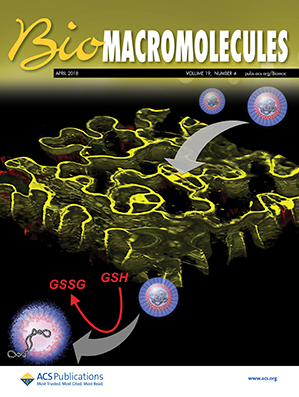使用巯基烯水凝胶进行双重药物递送的局部癌症治疗。
IF 5.4
2区 化学
Q1 BIOCHEMISTRY & MOLECULAR BIOLOGY
引用次数: 0
摘要
联合癌症治疗受益于可注射的水凝胶,用于局部、受控的药物输送。研究了巯基修饰透明质酸(HASH)与乙烯砜修饰β-环糊精(CDVS)交联形成的巯基共轭水凝胶。通过不同HASH分子量(23或99 kDa)和cdv改性(16%或33%),合成了4种配方(23Gel-16、23Gel-33、99Gel-16、99Gel-33)。流变学分析证实,随着分子量的增加和改性(99Gel-33 > 99Gel-16 > 23Gel-33 > 23Gel-16),粘弹性增强。该系统能够联合递送阿霉素(DOX)和卡维罗(CRV),表现出肿瘤反应性降解和可调节的释放。在模拟肿瘤条件下,DOX释放加速(46小时100%,PBS为58.7%),而CRV表现为初始爆发,随后持续释放。水凝胶促进间充质干细胞增殖,有效抑制三阴性乳腺癌细胞。这种可注射的、肿瘤反应性的水凝胶系统为微创、个性化的癌症治疗提供了一个有前途的平台。本文章由计算机程序翻译,如有差异,请以英文原文为准。
Localized Cancer Treatment Using Thiol–Ene Hydrogels for Dual Drug Delivery
Combinatorial cancer therapy benefits from injectable hydrogels for localized, controlled drug delivery. This study presents a thiol–ene conjugated hydrogel formed by cross-linking thiol-modified hyaluronic acid (HASH) with vinyl sulfone-modified β-cyclodextrin (CDVS). Four formulations (23Gel-16, 23Gel-33, 99Gel-16, 99Gel-33) were synthesized by varying HASH molecular weight (23 or 99 kDa) and CDVS modification (16% or 33%). Rheological analysis confirmed enhanced viscoelasticity with increasing molecular weight and modification (99Gel-33 > 99Gel-16 > 23Gel-33 > 23Gel-16). The system enabled combinatorial delivery of doxorubicin (DOX) and carvacrol (CRV), exhibiting tumor-responsive degradation and tunable release. DOX release accelerated under tumor-mimicking conditions (100% in 46 h vs 58.7% in PBS), while CRV showed an initial burst followed by sustained release. The hydrogel promoted mesenchymal stem cell proliferation and effectively inhibited triple-negative breast cancer cells. This injectable, tumor-responsive hydrogel system offers a promising platform for minimally invasive, personalized cancer therapy.
- Download: Download high-res image (137KB)
- Download: Download full-size image
求助全文
通过发布文献求助,成功后即可免费获取论文全文。
去求助
来源期刊

Biomacromolecules
化学-高分子科学
CiteScore
10.60
自引率
4.80%
发文量
417
审稿时长
1.6 months
期刊介绍:
Biomacromolecules is a leading forum for the dissemination of cutting-edge research at the interface of polymer science and biology. Submissions to Biomacromolecules should contain strong elements of innovation in terms of macromolecular design, synthesis and characterization, or in the application of polymer materials to biology and medicine.
Topics covered by Biomacromolecules include, but are not exclusively limited to: sustainable polymers, polymers based on natural and renewable resources, degradable polymers, polymer conjugates, polymeric drugs, polymers in biocatalysis, biomacromolecular assembly, biomimetic polymers, polymer-biomineral hybrids, biomimetic-polymer processing, polymer recycling, bioactive polymer surfaces, original polymer design for biomedical applications such as immunotherapy, drug delivery, gene delivery, antimicrobial applications, diagnostic imaging and biosensing, polymers in tissue engineering and regenerative medicine, polymeric scaffolds and hydrogels for cell culture and delivery.
 求助内容:
求助内容: 应助结果提醒方式:
应助结果提醒方式:


